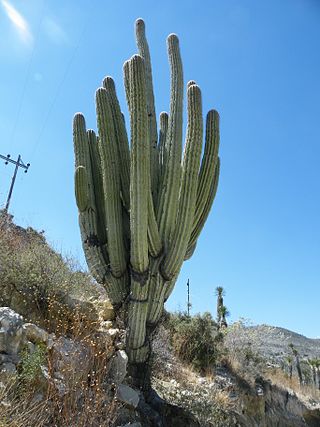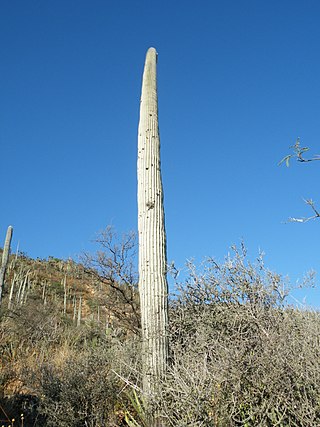
Cephalocereus senilis, the old man cactus, is a species of cactus native to Hidalgo and Veracruz in central Mexico. It is threatened in the wild, but widespread propagation and popularity in cultivation have reduced the demand on wild populations.

Neoraimondia is a genus of medium to large cacti from Peru. The genus is named after the Italian-born Peruvian explorer, naturalist, and scientist, Antonio Raimondi.

Pediocactus is a genus of cacti. The genus comprises between 6 and 11 species, depending upon the authority. Species of this genus are referred to as hedgehog cacti, though that name is also applied to plants from the genera Echinocereus and Echinopsis. Species may also be referred to as pincushion cacti, a common name which is also applied to other genera.

Parodia is a genus of flowering plants in the family Cactaceae, native to the eastern slopes of the Andes in northwestern Argentina and southwestern Bolivia and in the lowland pampas regions of northeastern Argentina, southern Brazil, eastern Paraguay, and Uruguay. This genus has about 65 species, many of which have been transferred from Eriocactus, Notocactus and Wigginsia. They range from small globose plants to 1 m (3 ft) tall columnar cacti. All are deeply ribbed and spiny, with single flowers at or near the crown. Some species produce offsets at the base. They are popular in cultivation, but must be grown indoors where temperatures fall below 10 °C (50 °F).

Mitrocereus is a monotypic genus of cacti. Its sole species is Mitrocereus militaris, native to Mexico.

Espostoa is a genus of columnar cacti, comprising 16 species known from the Andes of southern Ecuador and Peru. It usually lives at an altitude of between 800m and 2500m. Its fruit is edible, sweet, and juicy. The genus is named after Nicolas E. Esposto, a renowned botanist from Lima.

Rauhocereus is a monotypic genus of cacti. Its only species is Rauhocereus riosaniensis, which has nocturnal flowers. It is known from northern Peru.

Lophocereus marginatus is a species of plant in the family Cactaceae. It is sometimes called Mexican fencepost cactus.

Espostoa lanata is a species of cactus of the genus Espostoa.

Oreocereus trollii, commonly known as the Old Man of the Andes cactus, is a species of cacti native to Argentina and Bolivia. Though listed as Least Concern by the IUCN, the plant is collected extensively, and in some areas is threatened.

Pachycereus weberi is a columnar cactus plant native to Mexico.

Cephalocereus fulviceps is a species of Cephalocereus from Mexico.

Cephalocereus macrocephalus, synonym Neobuxbaumia macrocephala, is a species of cactus endemic to Mexico.

Cephalocereus columna-trajani is a species of cactus from Mexico.

Cephalocereus euphorbioides is a species of Cephalocereus from Mexico.

Cephalocereus mezcalaensis is a species of Cephalocereus from Mexico.

Cephalocereus tetetzo is a species of cactus from Mexico.
Cephalocereus apicicephalium is a species of cactus from Mexico.

Cephalocereus scoparius is a species of Cephalocereus from Mexico.

Cephalocereus polylophus is a species of cactus endemic to Mexico. Often grown under the synonym Neobuxbaumia polylopha, it is popular with cactus growers and reproduces well in cultivation.




























